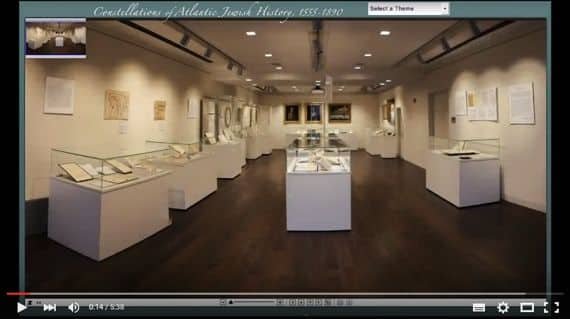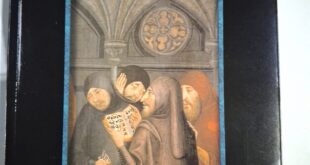The Arnold and Deanne Kaplan Collection of Early American Judaica
Exhibited February 12,2015 – June 9, 2015 in the Penn Libraries’ Goldstein Family Gallery
http://sceti.library.upenn.edu/kaplanexhibit/
During the 16th century and continuing over four centuries, Jews and their descendants forged extensive networks of kinship, commerce, and culture around the Atlantic coasts of Europe, Africa, South and North America, and beyond. The history of these Atlantic Jewries spans generations of colonization, revolutionary wars, cultural transformations, and continental crossings. Their relationships transcended imperial, national, religious and racial boundaries even as their paths to religious freedom and citizenship within politically controlled spaces advanced unevenly. Jews had to fight for their rights and respect as equal members of the communities in which they lived; they also had to confront the wrongs of slavery and racism in the societies in which they were embedded. Jews fought in and survived the violence and upheaval caused by wars. And whether in times of war or peace, they continued to form families, build religious and charitable institutions, self-consciously resist threats of radical assimilation, and creatively address pressures for religious change.
Many crossed the Atlantic for economic opportunities; others to escape oppressive conditions in their native lands. Economic life was fraught with uncertainty; while some prospered, others suffered. Cycles of boom and bust, success and failure afflicted everyone. Amidst sweeping change and uncertainty, optimism and anxiety, faith and doubt, new publishing ventures emerged and new forms of reading functioned as a social glue and as a calming balm connecting Jews and non-Jews of diverse backgrounds. In the nineteenth century, by foot, mule, horse, wagon, and rail thousands of Jews moved further inland settling across the Continental Americas until they reached the Pacific Ocean. They also came west by ship through the Caribbean to the Gulf of Mexico and around the southern tip of South America heading north to Latin America and the Pacific coast of the United States. Even as they reached the Pacific, Jews living in the Americas and across the Atlantic remained intimately connected to each other and part of an Atlantic Jewish historical and cultural geography.
The Arnold and Deanne Kaplan Collection of Early American Judaica teaches us about the everyday lives and businesses of these Atlantic Jewries and their changing perceptions and experiences of space and time – both as Jews and as members of their larger societies. As you go through this exhibition, thus, you may wish to don metaphorically an invention of Penn’s founder, Benjamin Franklin: a pair of bi-focals. These near and far-sighted spectacles hopefully will help disclose the particular and universal aspects of Atlantic Jewish history on display. The collection, in short, is more than the sum of its parts. It is the constellation of unlimited potential connections among its many pieces. To appreciate fully its significance and complexity requires an intensive immersion in its details and a keen awareness of the contexts in which each item first belonged. This exhibition, consisting of only a tiny sample of over 11,000 items, also, hopefully will help the viewer to better appreciate the decades of effort the Kaplans devoted to building a scholarly resource of lasting worth.
Acknowledgments
This exhibition, its design and mounting, as well as its companion volume, would not have been possible without the devoted, creative labors of Andrea Gottschalk, Exhibition Designer & Coordinator for the Rare Book and Manuscript Library , her conscientious staff, Sammi Paek, David Smigen-Rothkopf, and Emily White, and the exceptionally patient, professional copy-editing and proof-reading of Janice Fisher. The web-based presentation of this exhibition has been created thanks to the exceptional design skills of Dennis Mullen and the photographic talents of Chris Lippa.
Credit and great thanks for building this exhibition’s interactive digital map display of the Kaplans’ Victorian Jewish Trade Cards belongs to Doug Emery, Arthur Mitchell Fraas, Dennis Mullen, Michael Overgard, and Dot Porter.
Michael Overgard deserves special recognition for the superlative role he played coordinating and managing the logistics of the Kaplan exhibition. Carton Rogers, Vice Provost and Director of Libraries, William Noel, Director of the Kislak Center for Special Collections, Rare Books, and Manuscripts and Director of the Schoenberg Institute for Manuscript Studies, and Tina Cowan, Director of Development for the Penn Libraries provided truly great leadership and support. Ivy Barsky, CEO and Gwen Goodman Director, and Josh Perelman, Chief Curator and Director of Exhibitions and Collections at the National Museum of American Jewish History (NMAJH), enthusiastically embraced this project and partnership. Claire Pingel, the Chief Registrar and Associate Curator at the NMAJH, was indefatigably helpful in her multiple roles coordinating the exchange of Kaplan items between our two institutions. Lynn Smith and the staff of Atelier Art Storage and Services in Philadelphia expertly handled the packing, shipping, and storing of many of the Kaplan rare artifacts.
The following people all deserve recognition for their help bringing this project to fruition: Aleta Arthurs, Sue Bing, Ian Bogus, Chandra Victoria Collins, Jessie Dummer, Lynne Farrington, Josef Gulka, Regan Kladstrup, Judith Leifer, Chris Lippa, David McKnight, Bruce Nielsen, Jasmin Nof, John Pollack, Lynn Ransom, Louise Strauss, Elton-John Torres, Daniel Traister, and Ellen Williams. There is no adequate way to thank Arnold and Deanne Kaplan for their vision and generosity. Our boundless thanks go to them.
 eSefarad Noticias del Mundo Sefaradi
eSefarad Noticias del Mundo Sefaradi



